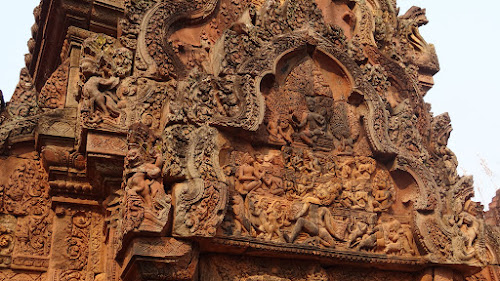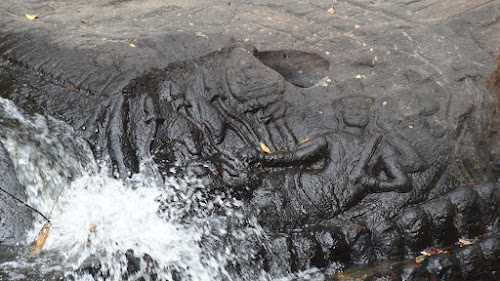Then Siem Reap. We haven't seen this many tourists since Luang Prabang in Laos, and being there in high season didn't seem to help. We got picked up at the bus station by a tuk-tuk driver and a sign carrying Annis name! The first time in 9 months of travel did we get picked up like 5 star tourists! The hostel we booked, based on the fantastic reviews, was indeed great. The owner, Mr Why Not is as charismatic as one can get and he has "his" own tuk-tuk drivers. We tried them all. Pick up was by Mr Beer o'clock whose favourite time every day is the time when he comes back with the last tour in the afternoon. Then he does what gave him his name.
The next day we left for the ruins. As said above, we didn't have a clue what to expect of Angkor Wat. The biggest religious building in the world? We found out, after studying a book about the ruins which was lent to us by Mr Why Not, that the Angkor Wat world heritage site actually consist of numerous temples in different places, each location marking a former capital of the Angkor kingdoms, ranging from 900 ad to 1300 ad (approximately, has to be enough). We started with the "big loop" or "grand circuit" as lots of things are in french. Also our driver, Bumpa, persisted in talking french to us after finding out that at least one of us has some rusty, barely used french words in his repertoire.
The big loop leads around the main attractions such as Angkor Wat for example. This, the worlds largest religious building, we saved for the second day, touring around the smaller sites first, we thought we'd be disappointed if we did the main stuff first. It was a great day! The "small sites" were all not that small and most of them very nicely restored. Soon we got confused by the names. "Do you wanna go to Prasat Ta Som, afterwards to Banteay Prei? Then Preah Khan? What? Good we had the book with us where we tried to follow the map and to figure out what this letter mess means. Basically "Wat" means temple. "Prasat" too. And "Preah" means temple, so does "Banteay". The difference is, I think I found out, that some were built during the Hindu period and some during the Buddhist. Doesn't matter actually, they're all fantastic. Some are quite small with few tourists, some vast and packed with white folks, some are high with steep stairs and a view from the top and some half eaten by the nature. We thought we'd get bored after a dozen or so but every temple has its own unique features, carvings or different coloured stones, we never got bored. Just tired of stairs. One of the last sights this day was the fantastic Ta Prohm. It's known through the movie Tomb Raider and Indiana Jones, and as crowded as it was it seems to be most peoples favourite. It was mostly left how it was found with trees growing over or from inside the temple. Large parts have collapsed and just small paths were cleared which makes it highly interestic to wander or climb through.
First stop was Angkor Wat. It's impressive but we expected more to be honest. It's massive, sure, but somehow there was no atmosphere in that one, unlike in some smaller ones. The queue to reach the top level was long and the checks for appropriate clothes unforgiving. Then we hiked up Phnom Bakheng, a hill topped with a temple. The temple itself is actually a huge pile of stones, they're working hard to restore it but the view from up there is stunning. 360 degrees of rainforest and Angkor Wat popping out of the trees like a crown. Our driver also promised us that there will be just the two of us up there. "Yeah right" we thought, "nice try". And we weren't alone. There was one other person. Worth the hike! Angkor Thom is just massive. It's not an actual temple but a huge area with several sites such as the elephant terrace, Baphuon, Bayon and many others. The Baphuon is in a pretty setting with a long stone bridge along ponds. Also very interesting is the fact that this temple had almost completely collapsed. A french lead the reconstruction and they took the whole thing apart, stone after stone, everyone marked with numbers and letters, everyone also marked on a plan. Sadly though, the Khmer Rouge destroyed the plan and the frenchman probably almost shot himself while standing in front of this giant, 3-D puzzle without a clue. It took them 51 years in total to finish the almost impossible and it looks fantastic! Respect!
Bayon was one of our top three, famous for the face towers and its very complex layout. Bo came to pick us up because we took the wrong exit in the Bayon and had to walk back. He just came back from an accident that happened not far away. One of the big buses (or coffins how I call them according to the average age of 126 of its passengers) overtook another bus and forced a tuk-tuk, coming against the bus, off the road and into a tree. It flipped over and a frenchman broke his arm. Cambodian style traffic even inside the world heritage... I just hope they learn from that.
Last day, last temples. We drove around 40 minutes to the north to Banteay Srei, a small but wonderful carved temple out of pink sandstone. Especially pretty in the light of a rising sun in the morning. Then the most unique site, Phnom Kulen. It lies inside a national park on a holy hill and consist of carvings in the stones of a riverbed. Some are figures like Vishnu and Shiva and some just patterns. Very pretty. Last temple was Banteay Samrae, a small but pretty temple where you will probably be alone. It was one of our favourites too but we didn't spend more than 15 minutes in there we were, finally, done with Wats.
Our top five temples:
Ta Prohm (overgrown)
Bayon (face towers, complexity)
Phnom Bakheng (view from top)
Preah Khan (overgrown, colours, carvings)
Angkor Wat (size, complexity, carvings in gallery)
If you have enough time, go to the remote ones:
Banteay Srei (carvings, colour)
Phnom Kulen (carvings in river, nice walk through forest)
On the way back to Phnom Penh we did a little detour to Kratie. It is the best place to spot Irrawaddy dolphins in the Mekong. Kratie itself is nothing special, almost boring after so many asian cities. But the dolphins are the reason to come here. We took a tuk-tuk for the 15km up the Mekong to the place where the boats depart. We were sceptical about seeing dolphins, the river is massive even in the dry season, and the estimated 75 dolphins could be anywhere! But after barely 10 minutes on the river we saw a group of 3 whose we observed for around an hour. Being a dolphin photographer must be the most depressive job on earth though. You hear them breathing on the surface, surely not where you expected them to surface and before you actually saw them they're already gone. After that we headed a bit further north and arrived at a place with islands and rapids. They built bridges and houses into the river and wedding couples were busy taking pictures and preparing the festivities. We instead went for a swim in the Mekong. Nice and refreshing in beautiful scenery!
Then we headed back to Phnom Penh to catch our flight to Kuala Lumpur. We still had some days left in the capital and we met with an old army friend of mine who I haven't seen for 7 years. Together we visited the crowded O'Russei market and the hill temple, Wat Phnom which was a slight disappointement, unlike in the description there is no view of the city just of trees which is also nice I guess. Then it was time to pack our bags the last time in Cambodia, harder than expected for us. Cambodia is hard to leave.












































